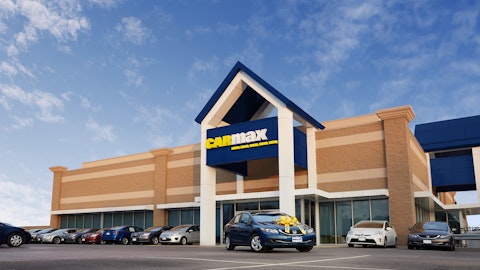Bill Nash: Yes, I’ll tell you, John, if you know, I appreciate a call afterwards, and let’s talk about it if you know the answer to that. I don’t — right now, I don’t foresee there’s nothing I can say that would say, okay, tax season is going to be dramatically different than last year. I mean I think in tax season, you expect to sell more cars, I think it will be similar. I think what’s going to be interesting is last year, at the beginning of the calendar year. There was really steep appreciation in vehicles. And I think it will be interesting. We aren’t counting on that steep appreciation. So it will be interesting to see the year-over-year dynamics of that from a pricing standpoint. But as we sit here right now, we’re kind of planning a tax season that was similar to last year because we don’t really see any signs that make it dramatically different.
Operator: We’ll go now to Sharon Zackfia with William Blair.
Sharon Zackfia: I guess a follow-up on that. Have you changed the way you show inventory on the website? Because it does look like there’s been a big inventory build so far in the last few months. And if you’re not expecting kind of a sea change in the tax refund season, I’m just curious on why we’re seeing that inventory build.
Bill Nash: Yes, Sharon, that’s a great question. And — what you’re seeing there is if you look at the average saleable inventory for the quarter, year-over-year, and the average, it’s very similar to last year. If you look at the end of the quarter, to your point, it’s up. And the reality is total inventory is up a little bit, and it’s up in salable versus non-salable. And the reason it’s up in salable is because we’re planning some production shutdown. If you remember, last year, the holiday fell on the weekend well we don’t build cars on the weekend. This year, it falls on a day, both January, but the first and December 25th fall on weekdays. And we want to give our folks time off and be able to join the holidays. So we actually did a little bit of a pre-build early on to make sure that we took in consideration that we want to have the shops closed and give time off for the holiday.
So, it’s really — that’s kind of what you’re seeing. There is a little bit of year-over-year dynamics as well, but that’s the bulk of what you’re seeing.
Sharon Zackfia: Okay. And any thought process yet on kind of how you’re viewing expansion from a unit standpoint for next year?
Enrique Mayor-Mora: For new locations?
Sharon Zackfia: Yes.
Enrique Mayor-Mora: Yes, we’ll provide that guidance in we usually provide that guidance in our Q4 call, and that’s what we’ll intend to do.
Operator: We’ll go next to Chris Bottiglieri with BNP Paribas.
Chris Bottiglieri: I was just hoping you could elaborate on the comment on not expecting to see a profit share in ESP. Would you expect F&I in Q4 to be similar to Q3? Is the historical seasonal difference primarily profit share? And then, does that have any spillover effect into next fiscal year, like in terms of how you set the — I don’t know, like anyway, just is there any spillover effect from the lower Q4 profit share?
Enrique Mayor-Mora: Yes. Thanks for the question, Chris. The seasonal effect is really more related to sales, right, and as sales map, so ESP penetration in dollars. So the only thing we’ve seen in the past couple of years is really in the fourth quarter where we’ve seen that profit share from our partners materialized at the end of the quarter. And last year was pretty material. I think it was over $15 million. And so I wanted to make sure we called that out. Just given the inflationary pressures that our partners have seen over the past year, it’s just made their profitability a little bit more pinched. And at the end of the day, when we look for profit share, there needs to be a certain amount that they’re seeing for us to have that — to share in that. So what we’ve anticipated so far for this year is that we will not see that profit share. But again, that’s really due to inflationary pressures that our partners are seeing.
Chris Bottiglieri: Got you. Okay. And then I was hoping you could kind of elaborate on the warehouse portfolio. It’s roughly 2/3 the size of the kind of securitized stuff. Like could you just maybe tell us a little bit more about what’s in there? What’s the average age today versus the securities portfolio? If you were to look at these like non-securitized non-Tier 2, 3 test receivables, like how does the loss performance of those vintages compared to like the like-for-like vintages that are in the securitized book? It sounds like you’re signaling that it’s better, but I was hoping you can just kind of elaborate on that a little bit more.
Jon Daniels: Sure. Yes, I’ll take that one, Chris. Yes, really, our warehouse lines provide that short-term funding until we take it to an ABS market or we look at other instruments to do a more permanent funding solution there. But our conduit lines right now primarily hold the newest assets until we take them to the market. So you’ve got — this quarter stuff is going to sit there. Last quarter stuff is going to sit there. Let’s call that $4 billion. There could be some spillover as well. So as we’ve mentioned, we’ve done significant tightening certainly from the Tier 3 and Tier 2. But if we isolate the Tier 1, we’ve tightened in the Tier 1 space. we would absolutely expect those Tier 1 assets to perform better than what’s in the securitization. Again, all of it, we think it performs very well. But from a loss perspective, in particular, that conduit stuff is going to be a lower loss than what you’re seeing in the most recent securitizations.


